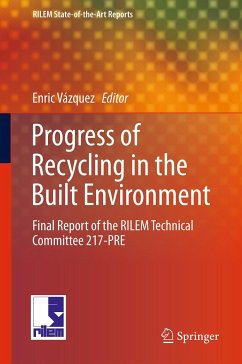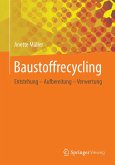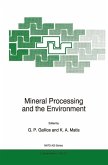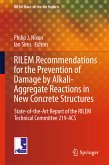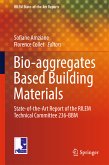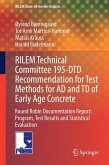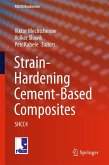Progress of Recycling in the Built Environment (eBook, PDF)
Final report of the RILEM Technical Committee 217-PRE
Redaktion: Vázquez, Enric
113,95 €
113,95 €
inkl. MwSt.
Sofort per Download lieferbar

57 °P sammeln
113,95 €
Als Download kaufen

113,95 €
inkl. MwSt.
Sofort per Download lieferbar

57 °P sammeln
Jetzt verschenken
Alle Infos zum eBook verschenken
113,95 €
inkl. MwSt.
Sofort per Download lieferbar
Alle Infos zum eBook verschenken

57 °P sammeln
Progress of Recycling in the Built Environment (eBook, PDF)
Final report of the RILEM Technical Committee 217-PRE
Redaktion: Vázquez, Enric
- Format: PDF
- Merkliste
- Auf die Merkliste
- Bewerten Bewerten
- Teilen
- Produkt teilen
- Produkterinnerung
- Produkterinnerung

Bitte loggen Sie sich zunächst in Ihr Kundenkonto ein oder registrieren Sie sich bei
bücher.de, um das eBook-Abo tolino select nutzen zu können.
Hier können Sie sich einloggen
Hier können Sie sich einloggen
Sie sind bereits eingeloggt. Klicken Sie auf 2. tolino select Abo, um fortzufahren.

Bitte loggen Sie sich zunächst in Ihr Kundenkonto ein oder registrieren Sie sich bei bücher.de, um das eBook-Abo tolino select nutzen zu können.
This report is a useful tool for countries starting to recycle aggregates or construction and demolition waste. It contains the latest developments in this field, introduces a completely new approach to the procedure of proportioning concrete mixtures with recycled aggregate, references recent publications, opinions and discrepancies in relation to the durability of recycled concrete, such as freeze-thaw standards, studies of chloride penetration and diffusion, and sulfate attacks, the use of the fine fraction
- Geräte: PC
- ohne Kopierschutz
- eBook Hilfe
- Größe: 9.41MB
Andere Kunden interessierten sich auch für
![Baustoffrecycling (eBook, PDF) Baustoffrecycling (eBook, PDF)]() Anette MüllerBaustoffrecycling (eBook, PDF)26,99 €
Anette MüllerBaustoffrecycling (eBook, PDF)26,99 €![Mineral Processing and the Environment (eBook, PDF) Mineral Processing and the Environment (eBook, PDF)]() Mineral Processing and the Environment (eBook, PDF)161,95 €
Mineral Processing and the Environment (eBook, PDF)161,95 €![RILEM Recommendations for the Prevention of Damage by Alkali-Aggregate Reactions in New Concrete Structures (eBook, PDF) RILEM Recommendations for the Prevention of Damage by Alkali-Aggregate Reactions in New Concrete Structures (eBook, PDF)]() RILEM Recommendations for the Prevention of Damage by Alkali-Aggregate Reactions in New Concrete Structures (eBook, PDF)73,95 €
RILEM Recommendations for the Prevention of Damage by Alkali-Aggregate Reactions in New Concrete Structures (eBook, PDF)73,95 €![Natural Fibres: Advances in Science and Technology Towards Industrial Applications (eBook, PDF) Natural Fibres: Advances in Science and Technology Towards Industrial Applications (eBook, PDF)]() Natural Fibres: Advances in Science and Technology Towards Industrial Applications (eBook, PDF)73,95 €
Natural Fibres: Advances in Science and Technology Towards Industrial Applications (eBook, PDF)73,95 €![Bio-aggregates Based Building Materials (eBook, PDF) Bio-aggregates Based Building Materials (eBook, PDF)]() Bio-aggregates Based Building Materials (eBook, PDF)129,95 €
Bio-aggregates Based Building Materials (eBook, PDF)129,95 €![RILEM Technical Committee 195-DTD Recommendation for Test Methods for AD and TD of Early Age Concrete (eBook, PDF) RILEM Technical Committee 195-DTD Recommendation for Test Methods for AD and TD of Early Age Concrete (eBook, PDF)]() Øyvind BjøntegaardRILEM Technical Committee 195-DTD Recommendation for Test Methods for AD and TD of Early Age Concrete (eBook, PDF)73,95 €
Øyvind BjøntegaardRILEM Technical Committee 195-DTD Recommendation for Test Methods for AD and TD of Early Age Concrete (eBook, PDF)73,95 €![Strain-Hardening Cement-Based Composites (eBook, PDF) Strain-Hardening Cement-Based Composites (eBook, PDF)]() Strain-Hardening Cement-Based Composites (eBook, PDF)161,95 €
Strain-Hardening Cement-Based Composites (eBook, PDF)161,95 €-
-
-
This report is a useful tool for countries starting to recycle aggregates or construction and demolition waste. It contains the latest developments in this field, introduces a completely new approach to the procedure of proportioning concrete mixtures with recycled aggregate, references recent publications, opinions and discrepancies in relation to the durability of recycled concrete, such as freeze-thaw standards, studies of chloride penetration and diffusion, and sulfate attacks, the use of the fine fraction <4mm, quality assurance of concrete recycled aggregate, sustainability and recycling construction waste and global impact assessment of urban renewal based on sustainable recycling strategies for construction and demolition waste. This volume will be of interest to recyclers, researchers and consumers.
Hinweis: Dieser Artikel kann nur an eine deutsche Lieferadresse ausgeliefert werden.
Dieser Download kann aus rechtlichen Gründen nur mit Rechnungsadresse in A, B, BG, CY, CZ, D, DK, EW, E, FIN, F, GR, HR, H, IRL, I, LT, L, LR, M, NL, PL, P, R, S, SLO, SK ausgeliefert werden.
Hinweis: Dieser Artikel kann nur an eine deutsche Lieferadresse ausgeliefert werden.
Produktdetails
- Produktdetails
- Verlag: Springer Netherlands
- Seitenzahl: 286
- Erscheinungstermin: 8. November 2012
- Englisch
- ISBN-13: 9789400749085
- Artikelnr.: 37773070
- Verlag: Springer Netherlands
- Seitenzahl: 286
- Erscheinungstermin: 8. November 2012
- Englisch
- ISBN-13: 9789400749085
- Artikelnr.: 37773070
- Herstellerkennzeichnung Die Herstellerinformationen sind derzeit nicht verfügbar.
1. INTRODUCTION AND ACTIVITIES; 1.1. OBJECTIVES OF THE BOOK; 1.2. ABSTRACT OF THE TC S ACTIVITIES (MEETINGS, METHODOLOGY, SYMPOSIA); References; 2. CONSTRUCTION AND DEMOLITION WASTE RECYCLING IN A BROADER ENVIRONMENTAL PERSPECTIVE; 2.1. Sustainability and recycling construction waste; 2.1.1. Introduction; 2.1.2. Defining and measuring sustainability; 2.1.1. Environmental drivers for recycling - closing the materials flow cycle; 2.1.1. The flow of mineral construction materials and construction waste; 2.1.2. Informal production of aggregates; 2.1.3. Economical drivers for recycled aggregates; 2.1.4. Social drivers; 2.1.5. Assessing sustainability of recycled aggregates; 2.1.1. The need for further developments; References; 2.2. Global impact assessment of urban renewal based on sustainable recycling strategies for Construction and Demolition Waste; 2.2.1. Why sustainable urban renewal is necessary; 2.2.2. How recycling strategies in urban renewal are applied; 2.2.3. How modelling supports the decision-making process; 2.2.4. Why european urban renewal projects are involved; 2.2.5. How recycling reduces CO2 emission; 2.2.6. How recycling signifies savings in primary resources; 2.2.7. How recycling contributes to diminishing the global impact of urban renewal in both developed and developing countries; 2.2.8. Appendix 1 : Calculation NATO Headquarters case; 2.2.9. Appendix 2 : Calculation City Harbour Rotterdam; References; 3. OVERVIEW REGARDING CONSTRUCTION AND DEMOLITION WASTE IN SEVERAL COUNTRIES; 3.1. Recycling in Belgium: An overview of the present situation in Belgium from the recycling industry and research about CDW; 3.1.1. Current market situation; 3.1.2. Standards and recommendations for application; 3.1.3. Principal problems related to standards and applications; 3.1.4. New applications and research; 3.2. Recycling in Brazil: An overview of the present situation of CDW in managing and recycling; 3.2.1. CDW generation and composition; 3.2.2. CDW management and recycling; References; 3.3. Recycling in North America: State-of-the art of RCA-concrete in North America; 3.3.1. Introduction; 3.3.2. Development of a New Mixture Proportioning Method for RCA-concrete; 3.3.3. Structural Behaviour and Strength of RCA-concrete Members; 3.3.4. Bond and Development Length; 3.3.5. Durability and Long-term Performance; 3.3.6. Research on RCA in Pavement Concrete; References; 3.4. Recycling in China: An overview of study on recycled aggregate concrete; 3.4.1. Introduction; 3.4.2. Mechanical properties of recycled concrete: Strength; 3.4.3. Behaviour of concrete under various stress stages; 3.4.4.Deformation characteristics; 3.4.5. Stress Strain relationship; 3.4.6. Durability; 3.4.7. Carbonization; 3.4.8. Chloride Penetration; 3.4.9. Freeze and Thaw; 3.4.10. Abrasion; 3.4.11. Structural performance of recycled concrete; 3.4.12. Reinforced RAC elements under monotonic loadings; 3.4.13. Reinforced RAC structures under cyclic loadings; 3.4.14. Shaking table tests on RAC structures; 3.4.15. Conclusions and recommendations; Acknowledgements; References; 3.5. Recycling in Germany: Overview regarding CDW in germany; 3.5.1. Amounts of Construction and Demolition Waste and fields of utilization; 3.5.2. Standards and recommendations; 3.5.3.New realizations and projects; References; 3.6. Recycling in Italy: Overview regarding construction and demolition waste; 3.6.1. Preliminary remarks about the method; 3.6.2. The production of recycled aggregates in Italy: Qualitative aspects; 3.6.3. Quantitative aspects; 3.6.4. Normative aspects; 3.6.5. A comparison with European data; 3.6.6.Characteristics of plants Tecnology; 3.6.7. The administrative procedure to install a recycling plant and the complementary activities; 3.6.8. Work modalities; 3.6.9. The recycled aggregates market; 3.6.10. Conclusion; References; 3.7. Recycling in the Netherlands;
1. INTRODUCTION AND ACTIVITIES; 1.1. OBJECTIVES OF THE BOOK; 1.2. ABSTRACT OF THE TC S ACTIVITIES (MEETINGS, METHODOLOGY, SYMPOSIA); References; 2. CONSTRUCTION AND DEMOLITION WASTE RECYCLING IN A BROADER ENVIRONMENTAL PERSPECTIVE; 2.1. Sustainability and recycling construction waste; 2.1.1. Introduction; 2.1.2. Defining and measuring sustainability; 2.1.1. Environmental drivers for recycling - closing the materials flow cycle; 2.1.1. The flow of mineral construction materials and construction waste; 2.1.2. Informal production of aggregates; 2.1.3. Economical drivers for recycled aggregates; 2.1.4. Social drivers; 2.1.5. Assessing sustainability of recycled aggregates; 2.1.1. The need for further developments; References; 2.2. Global impact assessment of urban renewal based on sustainable recycling strategies for Construction and Demolition Waste; 2.2.1. Why sustainable urban renewal is necessary; 2.2.2. How recycling strategies in urban renewal are applied; 2.2.3. How modelling supports the decision-making process; 2.2.4. Why european urban renewal projects are involved; 2.2.5. How recycling reduces CO2 emission; 2.2.6. How recycling signifies savings in primary resources; 2.2.7. How recycling contributes to diminishing the global impact of urban renewal in both developed and developing countries; 2.2.8. Appendix 1 : Calculation NATO Headquarters case; 2.2.9. Appendix 2 : Calculation City Harbour Rotterdam; References; 3. OVERVIEW REGARDING CONSTRUCTION AND DEMOLITION WASTE IN SEVERAL COUNTRIES; 3.1. Recycling in Belgium: An overview of the present situation in Belgium from the recycling industry and research about CDW; 3.1.1. Current market situation; 3.1.2. Standards and recommendations for application; 3.1.3. Principal problems related to standards and applications; 3.1.4. New applications and research; 3.2. Recycling in Brazil: An overview of the present situation of CDW in managing and recycling; 3.2.1. CDW generation and composition; 3.2.2. CDW management and recycling; References; 3.3. Recycling in North America: State-of-the art of RCA-concrete in North America; 3.3.1. Introduction; 3.3.2. Development of a New Mixture Proportioning Method for RCA-concrete; 3.3.3. Structural Behaviour and Strength of RCA-concrete Members; 3.3.4. Bond and Development Length; 3.3.5. Durability and Long-term Performance; 3.3.6. Research on RCA in Pavement Concrete; References; 3.4. Recycling in China: An overview of study on recycled aggregate concrete; 3.4.1. Introduction; 3.4.2. Mechanical properties of recycled concrete: Strength; 3.4.3. Behaviour of concrete under various stress stages; 3.4.4.Deformation characteristics; 3.4.5. Stress Strain relationship; 3.4.6. Durability; 3.4.7. Carbonization; 3.4.8. Chloride Penetration; 3.4.9. Freeze and Thaw; 3.4.10. Abrasion; 3.4.11. Structural performance of recycled concrete; 3.4.12. Reinforced RAC elements under monotonic loadings; 3.4.13. Reinforced RAC structures under cyclic loadings; 3.4.14. Shaking table tests on RAC structures; 3.4.15. Conclusions and recommendations; Acknowledgements; References; 3.5. Recycling in Germany: Overview regarding CDW in germany; 3.5.1. Amounts of Construction and Demolition Waste and fields of utilization; 3.5.2. Standards and recommendations; 3.5.3.New realizations and projects; References; 3.6. Recycling in Italy: Overview regarding construction and demolition waste; 3.6.1. Preliminary remarks about the method; 3.6.2. The production of recycled aggregates in Italy: Qualitative aspects; 3.6.3. Quantitative aspects; 3.6.4. Normative aspects; 3.6.5. A comparison with European data; 3.6.6.Characteristics of plants Tecnology; 3.6.7. The administrative procedure to install a recycling plant and the complementary activities; 3.6.8. Work modalities; 3.6.9. The recycled aggregates market; 3.6.10. Conclusion; References; 3.7. Recycling in the Netherlands;
